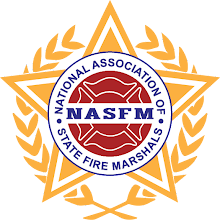National AssOCIATION OF State Fire MarshalsA strong united voice for fire prevention | Log In |
************************************************************************ Red Cross & NASFM Partnership in Disaster Response
******************************************************************** |
Save The Date! 36th Annual NASFM Fire Prevention & Safety Symposium August 14-20, 2026 |
***********************************************************************************
|
National Association of State Fire Marshals Proudly Supports
|
******************************************************************************* |
Retired State Fire Marshal Installs Fire Sprinklers in His Home Living Life.... Still Setting Examples!
|
*******************************************************************************
|
NEW! July 28, 2024
White Paper on Classroom Door Security & Locking Hardware Updated Position
The ability to protect students, teachers, and administrators from threatening situations is a high priority in all educational institutions. Many schools, school districts, colleges, and universities have taken measures to address this pressing concern of safety of occupants in schools, and especially classrooms. While protection against active shooters and violent events is a main concern, bullying and other affronts to personal safety also occur. Occupants of schools, including after-hours occupants, should be provided with a safe and secure educational environment.
Some of the proposed or implemented solutions specifically affecting classroom doors, while well intended, may compromise aspects of life safety while attempting to address security. For example, a barricade device or security lock that cannot be opened from the outside may create an environment for abuse. In addition to the demand to protect students and teachers from outside-the-classroom threats, classroom doors are required to comply with other life safety and accessibility provisions.
Click on the Link above for more info.
*************************************************************************************************************************************************************************************
NASFM PIO-Network
As part of the NASFM Strategic Plan, we launched a new program called NASFM PIO-Network or PIO-NET for short. The invitation announcement was made available for all state fire marshals who had a dedicated PIO / Marketing / CRR to participate. This group will work together to help NASFM in national media campaigns, serve as peers to other states, assist states that lack similar resources, and to coordinate media on a larger scale. The second meeting was held in mid-June with several states participating. One goal was to identify who had PIO / Marketing /CRR staff that would participate. Secondly, highlight the efforts of one State Fire Marshal’s Office each month in the newsletter.
If you or one of your team members would like to participate, please contact Gary West at Gary@browning.red to be added to the monthly one-hour Zoom call. Meeting is held on the Third Wednesday each month at 2pm Eastern / 1pm Central.New Fire Resource Guide The National Association of State Fire Marshals (NASFM) is proud to present a resource guide on residential fire sprinklers for code officials, builders, developers, and elected officials. The information serves as a source to ensure life safety concerns meet at least the minimum code requirements, regardless of whether residential fire sprinkler systems are required in their jurisdiction or not. “Residential Sprinkler Design Enhancements, A Resource Guide for AHJ’s, Builders, Developers, and Elected Officials” was compiled by the National Association of State Fire Marshals, Model Codes Committee, Sub-Committee on Code Amendments Related to Sprinklers. By clearly identifying all design enhancements allowed when residential sprinkler systems are installed, AHJ’s will be able to ensure that when residential occupancies are constructed without residential sprinkler systems these design enhancements are not allowed. This approach will help ensure that all residential occupancies in their jurisdiction are code compliant, regardless of whether a sprinkler system is installed at the time of construction or not. The intent is to identify design and construction protection features that require consideration to maintain an acceptable level of safety in one- and two-family dwellings where amendments or deletions have modified provisions of the codes. The purpose is to alert code officials, building design and construction professionals, and regulatory authorities and highlight the required alternative designs where the requirement for installation of automatic sprinkler protection has been removed. This guide deals exclusively with design enhancement options found in the 2021 Edition of the International Residential Code (IRC), as well as certain special allowances that are provided in the 2021 Edition of the International Fire Code (IFC) and the International Building Code (IBC), all of which are published by the International Code Council (ICC). If you have questions or need assistance in referencing this resource, please feel free to contact Phil Oakes (phil@browning.red) or Gary West (gary@browning.red) at the National Association of State Fire Marshals. For a copy of the guide click here |
NASFM works with the Safer Buildings Coalition on the Complete ERCES Handbook
This first-of-its-kind desk reference and study guide authored by the Safer Buildings Coalition, in collaboration with subject matter experts from across the industry and with the assistance of NASFM, includes comprehensive learning and reference material pertaining to Emergency Responder Communications Enhancement Systems (ERCES), plus everything you need to prepare for the NICET IB-PSC Certification.
The Handbook covers the following NICET IB-PSC certifications: Designer and Technician (Levels 1, 2 and 3), and is used as a reference for a variety of topics. It also includes an exclusive ERCES Vendor Directory to accelerate your search for knowledgeable industry resources.
The Safer Buildings Coalition's long-awaited Complete ERCES Handbook with NICET Study Guide is available to order today.
For more information, please visit https://erceshandbook.com
*******************************************************************************






.png)